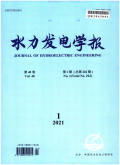水力发电学报2024,Vol.43Issue(5):24-34,11.DOI:10.11660/slfdxb.20240503
西南地区典型河道型水库水温结构及水动力机制研究
Study on water temperature structure and hydrodynamic mechanism of river-type reservoirs in southwest China
摘要
Abstract
For a large river-type reservoir that is operating for hydroelectric benefits,the impact of its unique water temperature stratification on the water environment cannot be neglected.Most of the previous studies focus on the vertical variation in water temperature and its temporal evolution,lacking an in-depth examination on the hydrodynamic effect during its formation.This study uses mathematical models to simulate and examine the varying process of water temperature structure in the Wudongde reservoir,a typical river-type reservoir in the southwest region.We find that hydrodynamic conditions are the decisive factor in forming certain water temperature structures,and the formation and evolution of the main thermoclines depend on the hydrodynamic mechanism caused by thermal density flow.From February to March,the incoming water plunges into the reservoir bottom,forming a main thermocline at the interface between the two layers,and continuously developing as it advances further downstream at the bottom;From April to June,the inflow plunges down as an intermediate layer,with two thermocline layers formed at its upper and lower edges separately;In July,the inflow stays on the surface as an upward floating flow with a main thermocline below it.In the case of the water intakes,the dynamic suction effect of its orifices causes the main thermoclines to contract locally in certain areas near the dam.关键词
河道型水库/水动力机制/水温结构/入流形态/数学模型Key words
river-type reservoirs/hydrodynamic mechanisms/water temperature structure/inflow patterns/mathematical models分类
水利科学引用本文复制引用
贺玉彬,时晓燕,周洪举,李星皓,万欣,张红,刘昭伟,任华堂..西南地区典型河道型水库水温结构及水动力机制研究[J].水力发电学报,2024,43(5):24-34,11.基金项目
国家重点研发计划项目(2022YFC3204602) (2022YFC3204602)
天府永兴实验室重大项目(2023KJGG15) (2023KJGG15)
清华四川能源互联网研究院重点创新项目(35030240026) (35030240026)

